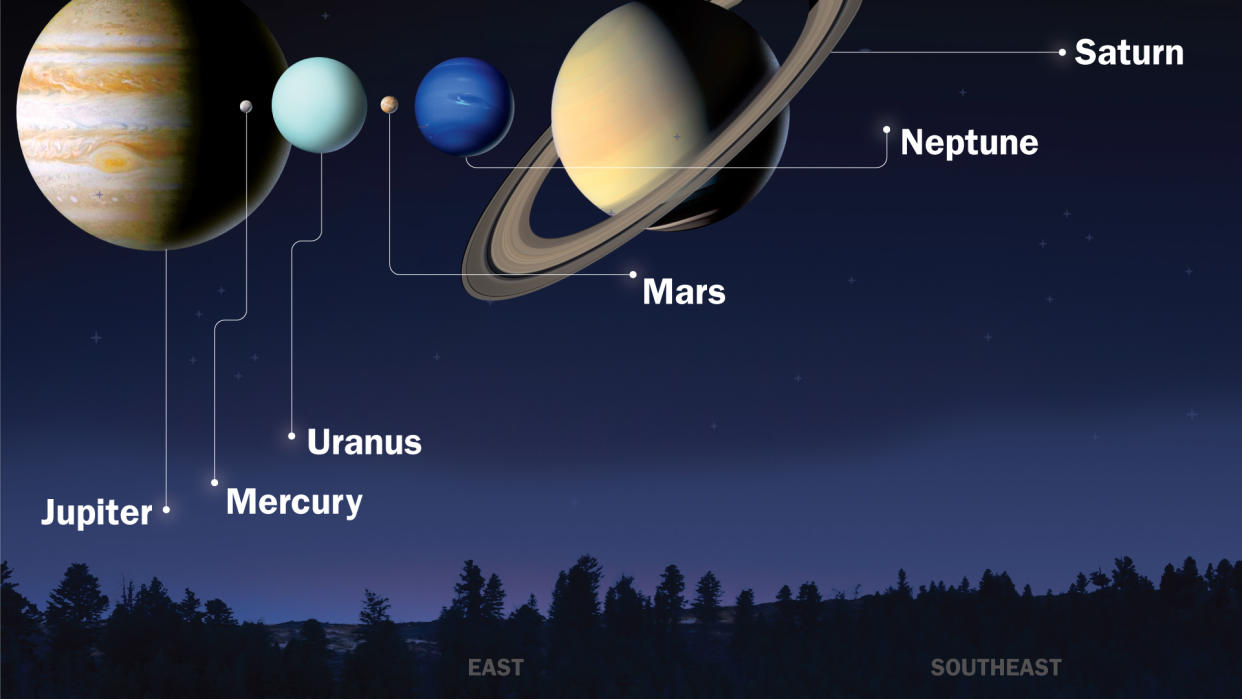A 'Parade of Planets' Is Coming. Here's How to Watch This Sky Show

Credit - Photo illustration by TIME; Getty Images
One of the solar system’s most fortuitous conga lines occurred in the late 1970s, when the four gas giants—Jupiter, Saturn, Uranus, and Neptune—formed a neat cosmic column, allowing the Voyager spacecraft to make flybys of all of them. The twin ships performed dazzling science, returning some of the best pictures ever taken of the worlds and discovering moons and rings never before seen.
Things won’t be quite as history-making on June 3, 2024, but they will be eye-popping all the same. It is on that date that stargazers in the U.S. and elsewhere in the world will have their best chance of seeing what is being colloquially called a parade of planets, when six of our solar system’s eight planets (nine if you count little disenfranchised Pluto) will be visible at once in the sky. The half dozen worlds on display will be Mercury, Mars, Jupiter, Saturn, Uranus, and Neptune, but they won’t all be easy to spot—and you’ll have to get up early to see them at all. Here’s what to know to take in this latest sky show.
What is a parade of planets?
For all of the stir the spectacle is causing, the parade is mostly an optical illusion, with the planets not truly lining up the way they did in the Voyager era. Rather, they are scattered all across the sky at different depths, positions, and distances, and just happen to be visible at once in a 73° area. The phenomenon is a little like randomly placing six different people at six different spots in a field and positioning yourself so that you can gather them all in your camera lens at once.
Read More: How to Prepare for the Next Solar Storm
While true alignments are rare—the one that the Voyager probes took advantage of was the only one of its kind within a 176-year period—planetary parades are relatively common. Another six-planet parade will be visible on August 28, 2024, and four others, some consisting of just three or four planets, will occur between then and August 2025.
Where will the planets be?
It will take some doing to find just where each planet is located in the sky. According to the stargazers’ site Stellarium, Jupiter and Mercury, which in fact are 448 million miles apart, will appear to be huddled up close to each other, near the horizon. Moving up to the Northeast will be Uranus, followed by Mars, Neptune, and finally Saturn. Adding its own little fillip, a crescent moon will also be visible in the midst of the parade.
Not all of the planets will be equally visible. Bright-red Mars and giant Saturn will be the easiest to see with the naked eye. Mercury and Jupiter won’t be quite as conspicuous. Uranus and Neptune, meanwhile—the most remote of the group—will require high-power binoculars or a telescope.
When can I spot the planets?
The skywatching window is narrow for the planet parade. The best viewing occurs about 20 minutes before sunrise, while looking to the eastern horizon. In New York on June 3, that means 5:06 a.m. At the lower latitude of Cape Canaveral, that means 6:05 a.m. In Los Angeles, it’s 5:02 a.m.
Read More: Newly Discovered Planet May Be Able to Support Human Life
Elsewhere in the world, the parade will be visible before June 3. In São Paolo, Brazil, for example, it will commence on May 27 and cover a 43° expanse of sky; in Mexico it begins on May 29 across a 65° sector; in Athens the curtain goes up on June 2, in a 72° patch. Whenever the parade begins, it should last no more than a week—visible in the same pre-dawn window—depending on your location.
As with all cosmic phenomena, the farther you are from the light pollution of the city, the better your viewing will be. Truly dark skies are becoming a rarer and rarer thing in the modern world, but they’re worth seeking out. The heavens have a lot to show us—but only if we meet them on their terms.
Write to Jeffrey Kluger at jeffrey.kluger@time.com.


